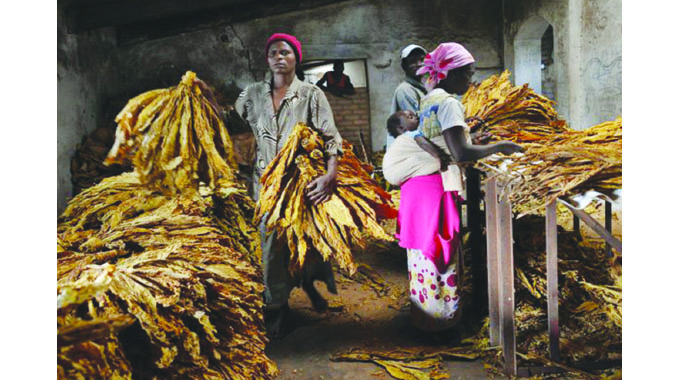Treat tobacco selling season with same caution

Obert Chifamba
Agri-Insight
IT’s been a while now since farmers with early planted irrigated tobacco started reaping and curing their produce in readiness for the 2021 marketing season, which is projected to start next month, all things being equal.
The Tobacco Industry and Marketing Board (TIMB) is also in the midst of earnest preparations for the selling season of the golden leaf.
The last time I checked they had registered three auction floors in Harare — Boka, Tobacco Sales Floor (TSF) and Premier — that managed to beat the September 30 deadline for license application.
The tobacco regulatory board has since shifted attention to those tobacco floors that will be operating outside Harare as part of decentralisation efforts to ensure farmers access markets at minimal costs.
This will also feed well into the current efforts to make certain tobacco selling points are de-congested and ensure farmers are spending the least possible time doing their business in line with Covid-19 protocols that require all people to observe social distancing and avoid crowded environments.
It is uplifting to note that TIMB has since started working on the operational modalities for this year’s marketing season to ensure business is done in the safest possible environment for all stakeholders in the industry given the current spike in Covid-19 cases and deaths under the second wave.
But while TIMB is attending to the outstanding requirements for the season to start, those farmers that are currently reaping their crop also need to adjust their curing methods to protect the quality of the leaf in line with the change in rainfall patterns from last season to the current term.
It is not rocket science that this season will see an improvement in the quality of the crop thanks to the rainfall amounts that the crop has received compared to last year.
If not careful, farmers may easily ruin the quality of their leaf if they use the same curing methods they used last season given that this year’s crop has received more rains than last season’s, which makes the leaf softer and of a higher quality.
Soft leaves do not need the same temperatures during curing as those required by crops produced under predominantly dry conditions, as too much heat can cause shattering of the leaf.
This requires farmers to always monitor and control the temperatures in their barns if they want to produce good quality produce this season.
In fact, this diligence should start from the field where the farmers ought to make sure ripe leaves are harvested in time, as leaving them to endure the rains currently pounding the country will also ruin the quality.
Ripe leaves need to be harvested as soon as they are ready and farmers can ascertain this readiness by checking the leaves’ angle of attachment to the stem that will naturally drop or loosen if it is time to harvest them.
The leaves have to be attached at an angle of 45 degrees if they are not yet ripe, a position that will change to 90 degrees or so upon maturity.
They will also develop spots that are white in colour at the edges while they turn from green to yellowish.
Ripening leaves can easily be affected by too much irrigation water or rains, hence the need for them to be harvested once they are ready.
TIMB on the other hand should also use this time to finalise with the Reserve Bank of Zimbabwe (RBZ) on the payment modalities for tobacco farmers in the upcoming 2021 tobacco marketing season among other crucial preparations so that farmers go about their business fully aware of how they will be paid and prepare for that.
Announcing the payment system will also give impetus to the way farmers prepare their crop for the market since they are business people who need to plan and also make payments to many service providers they would have dealt with throughout the season.
The tobacco marketing season is known to be a time when liquidity in the economy improves, as there will be fresh capital injections coming with the merchants that would have been licensed to do business here.
This means that everybody will always be eagerly waiting for that time, so TIMB needs to move mountains and get the playing field ready soon.
TIMB chief executive officer Dr Andrew Matibiri recently told me that the board was going through applications by buyers to ensure that those that are eventually licensed to operate will be able to meet the national regulations on buying the golden leaf.
If possible, they should include a clause speaking against the erection of price ceilings somewhere along the course of the season and clearly spell out what can happen to errant buyers.
Price ceilings have ruined the vibe in most seasons with farmers expressing genuine concerns that prices offered on the first day when low quality leaf (usually primings) will be on sale should be easily eclipsed by prices that come as the season progresses.
This has not been happening most of the times.
Tobacco output for the 2021 season is expected to rise given that the number tobacco growers who have registered to produce the crop.
Figures have reached 144 462 compared to 143 568 who had registered during the same period last season.
Of the total figure, 1 715 are new.
A total of 100 672 hectares of the crop have planted compared to 70 198 hectares planted during the same period last season.
On the other hand, 36 contractors have been registered to operate this season while 135 935 growers are producing their crop under contract.
So far 4 836 tonnes of Compound C and 528 tonnes of Ammonium Nitrate fertilisers have been distributed to approximately 12 089 small-scale growers through the Tobacco Inputs Credit Scheme (TICS) programme.
The total distributed inputs can cover an equivalent of approximately 12 089 hectares.









Comments